Applying Aruba Switching Fundamentals for Mobility (ACSA) v1.0
Question 1
Refer to the exhibit.
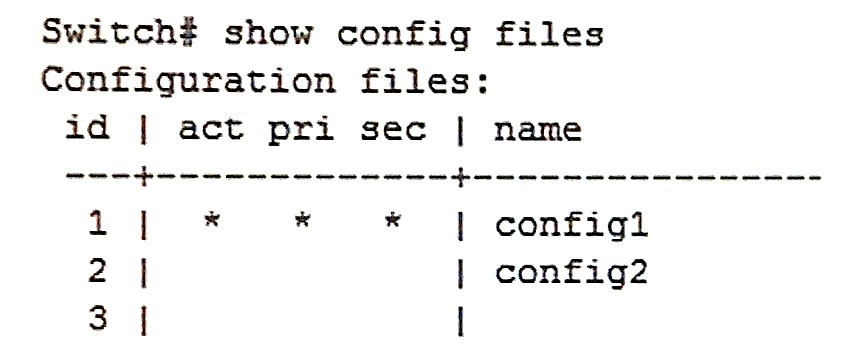
A network administrator views the configuration files on an ArubaOS switch and sees the output in the exhibit. The administrator enters this command:
Switch# boot system flash primary config config2
After the switch boots, the administrator makes some configuration changes and saves the configuration with the write memory command. The administrator then enters this command:
Switch# boot -
After the switch boots, the configuration changes just made are not present.
How can the administrator restore the configuration with the changes?
- A. Use the boot set-default command to configure the switch to use the secondary software. Then reboot the switch.
- B. Reboot the switch and interrupt the boot process. Find the temporary file with the configuration changes and apply that file to the startup-config.
- C. Rename the config2 file to config1. Then reboot the switch.
- D. Use the startup-default command to configure the switch to use the config2 file with the primary software. Then reboot the switch.
Answer : D
Question 2
For which task does a network administrator need to access the enable context on an ArubaOS switch?
- A. to view interface statistics
- B. to view CPU statistics
- C. to ping an IP address
- D. to view configuration files
Answer : D
Question 3
A network administrator prepares an ArubaOS switch to be monitored and managed by AirWave.
Which credentials are required for AirWave to change configuration settings on the switch?
- A. RADIUS shared secret
- B. SNMPv2c community with manager unrestricted privileges
- C. Telnet or SSH password
- D. SNMPv3c user in the ManagerPriv group
Answer : C
Question 4
A company has an Aruba 5400R switch, switch 1, at the network core of its campus. This switch routes all traffic for the campus and is the RSTP root. The company now wants to add another Aruba 5400R switch to the core in order to enhance resiliency. The company wants to use the option that provides the best
Layer 2 and Layer 3 resiliency and also the simplest setup.
What should the administrator do to add the new 5400R switch?
- A. Add the new switch and migrate to MSTP with two instances.
- B. Add the new switch and set up OSPF on all switches.
- C. Add the new switch as a secondary root bridge in RSTP.
- D. Add the new switch as a standby member in a VSF fabric with switch 1.
Answer : C
Question 5
Which settings should match on physical interfaces before a network combines them in a link aggregation?
- A. speed and duplex mode
- B. DSCP and media
- C. speed and VLANs
- D. LLDP TLVs and VLAns
Answer : A
Question 6
Two switches are members of a Virtual Switching Framework (VSF) fabric.
Which statement correctly describes how the switches handle routing?
- A. Only the commander runs routing protocols and builds the IP routing table, but it programs the standby member to route traffic.
- B. Both members build their own IP routing tables, which they synchronize. Only static IP routing is supported with VSF.
- C. Only the commander runs routing protocols and builds the IP routing table, and all routed traffic must pass through the commander.
- D. Both members run routing protocols and build their own IP routing tables, and they synchronize the tables over VSF links.
Answer : C
Question 7
A server connects to a port on an ArubaOS switch. The network administrator wants to ensure that the port remains forwarding during MSTP topology changes, and changes in the port status do not cause MSTP topology changes.
Which statement describes how the administrator can accomplish this?
- A. The administrator can accept the default behavior of auto-edge.
- B. The administrator can lower the port"™s root path cost to zero.
- C. The administrator can manually disable STP on the edge port.
- D. The administrator can configure the port as an MSTP master port.
Answer : D
Question 8
Refer to the exhibit.
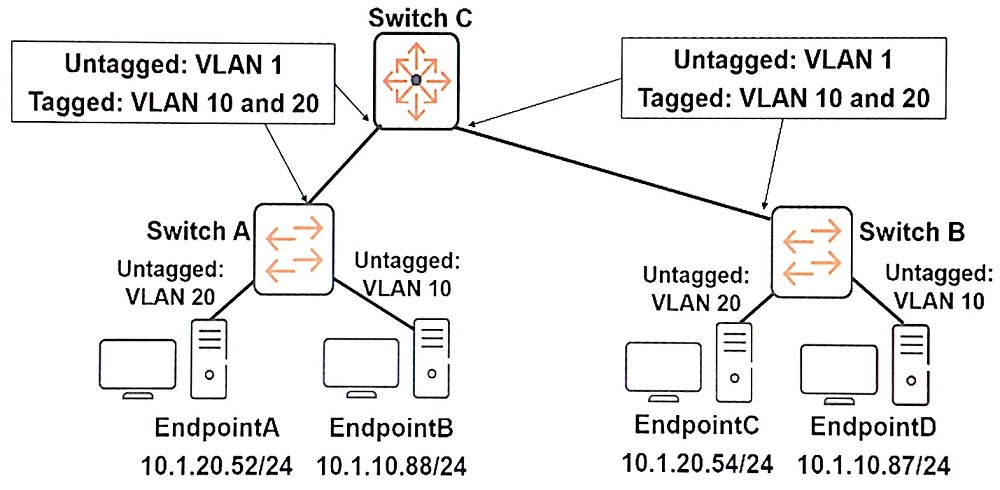
Endpoint A sends broadcast ARP requests.
Where are these requests received?
- A. at EndpointC
- B. at EndpointB
- C. at EndpointB, at EndpointC, and at EndpointD
- D. at EndpointB and at EndpointC
Answer : A
Question 9
A network administrator wants to be able to access an Aruba Instant cluster at the same IP address even if the current master fails.
How can the administrator achieve this goal?
- A. Configure a VC IP address that is a reserved IP address in the AP"™s subnet.
- B. Configure the AirWave IP address in the instant cluster System > Admin settings.
- C. Assign static IP addresses, rather than DHCP ones, to all APs in the instant cluster.
- D. Assign a static IP addresses, rather than a DHCP one, to the AP that is elected master.
Answer : A
Question 10
A network administrator discovers and then authorizes several ArubaOS switches in Aruba AirWave. Immediately after the administrator authorizes the switches,
AirWave cannot communicate with the switches anymore.
What should the administrator do to restore communication?
- A. Change the SNMP and Telnet/SSH credentials in the AirWave global communication settings to match those on the switches.
- B. Change the management level for the switches to Monitoring and Firmware Updates Only.
- C. Specify the SNMP and Telnet/SSH credentials on the switches to update the individual communication settings on the switches.
- D. Change the management level for the switches to Manage Read/Write.
Answer : C
Question 11
A company has a single routing protocol environment.
What is one reason to use OSPF routing instead of static routing?
- A. OSPF allows ArubaOS switches to use default routes, while static routes cannot use 0.0.0.0/0 as the destination network.
- B. OSPF has a lower default administrative distance than static routing on ArubaOS switches.
- C. OSPF reduces the risk of accidentally introducing routing loops, while static routing does not.
- D. OSPF permits load sharing traffic over multiple routes, while static routing does not.
Answer : C
Question 12
Refer to the exhibit.
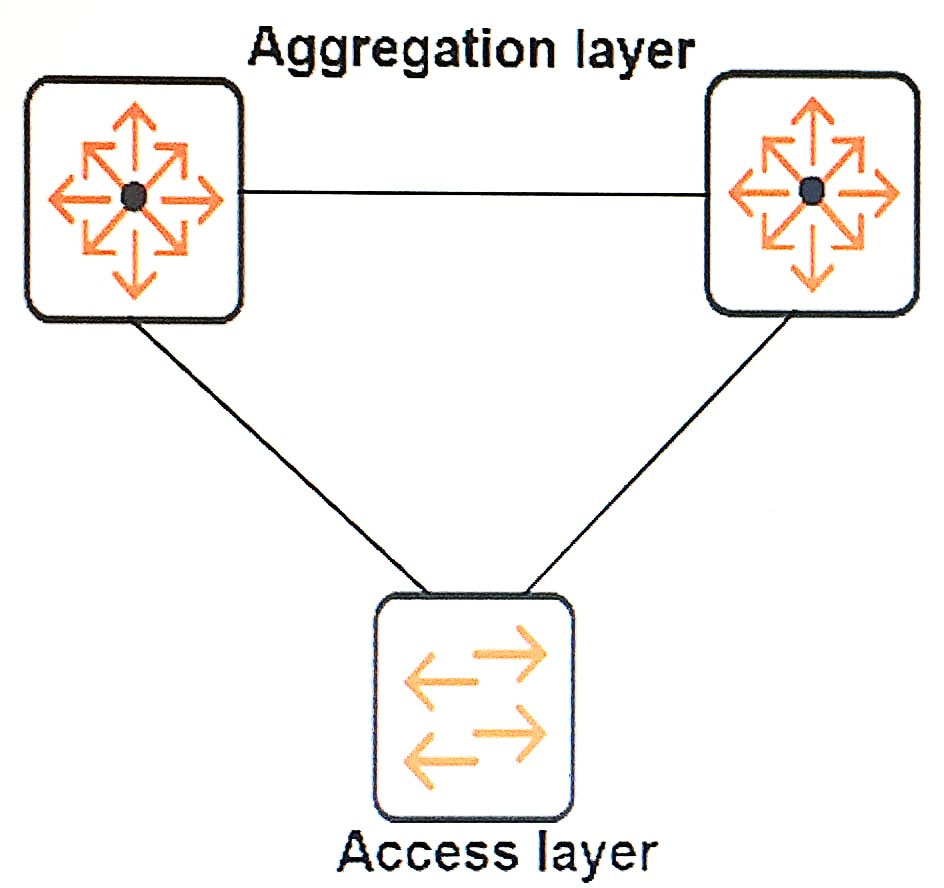
A network administrator installs a new aggregation and access layer in a campus network. All users in this area belong to the same VLAN. The administrator plugs the switches into the network with the factory default configurations.
Which protocol must the administrator configure to prevent broadcast storms?
- A. MSTP
- B. LLDP
- C. OSPF
- D. LACP
Answer : A
Question 13
A network administrator is in this context in an ArubaOS switch CLI:
Switch (vlan10)#
The administrator wants to leave the configuration context with a single command/
Which command should the administrator enter?
- A. logout
- B. quit
- C. exit
- D. end
Answer : B
Question 14
Refer to the exhibit.
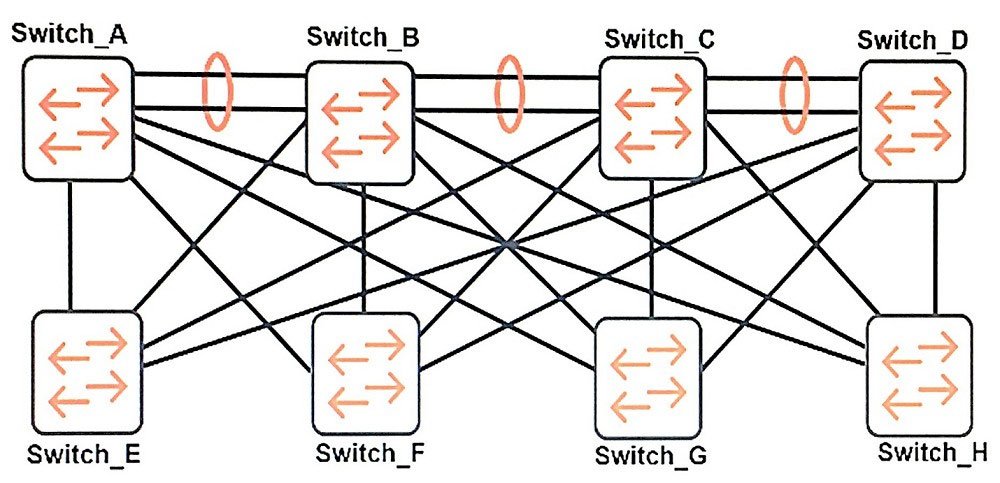
MSTP is implemented in the topology shown in the exhibit, and all the switches are in the same region. The network administrator does not want to use the
Internal Spanning Tree (IST) or instance 0 for production traffic.
How many non-IST spanning tree instances does this network need in order to have effective load sharing on the uplinks from the access switches?
- A. two
- B. three
- C. four
- D. five
Answer : C
Question 15
Refer to the exhibit.
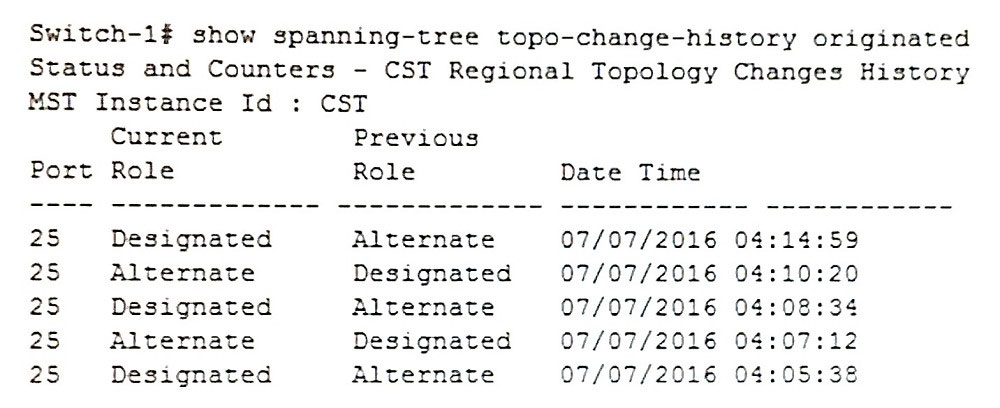
Based on the exhibit, what is the problem?
- A. An issue causes the spanning tree to converge and re-converge again and again.
- B. Interface 25 on Switch-1 is incorrectly configured as an STP edge port and cause a loop to occur.
- C. Interface 25 on Switch-1 does not support the correct VLANs and prevents the interface from receiving the correct STP role.
- D. Switch-1 and another switch are configured with the same spanning tree priority and cause the root election to occur again and again.
Answer : A